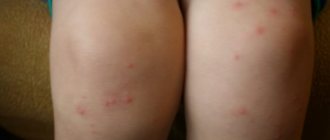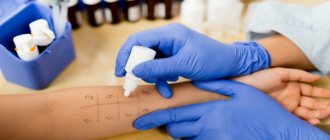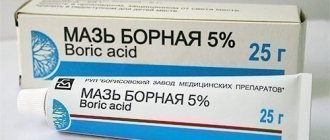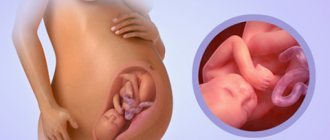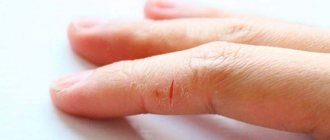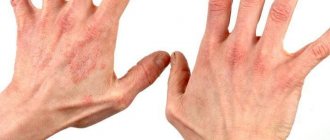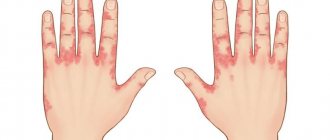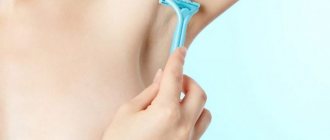Where do pimples on the palms come from? Such rashes, localized on the inside of the hand, are difficult for patients to tolerate due to constant burning and itching. Pimples can be completely harmless or be a symptom of serious abnormalities in the body. Let's try to figure out what causes the formation of small bubbles on the palms and how to get rid of this symptom.
To cure a disease, it is necessary to unravel its cause. Before you run headlong to the pharmacy for ointments or creams for small pimples on the palms, you need to find out what triggered their appearance, so it is unlikely that you will be able to do without the help of a professional dermatologist.
There are a number of specific reasons why small blistering formations form on the inside of the palm. Each of them deserves special attention.
Excessive sweating
Doctors call this phenomenon hyperhidrosis, the causes of which may be improper metabolism, frequent stress, and worries. Hyperhidrosis is common in people with diabetes. If pimples appear on the palms, it means that a bacterial infection has penetrated into small wounds and cracks. The thing is that pathogenic flora multiplies much more actively in sweaty palms. For microbes, a moist environment is what they need.
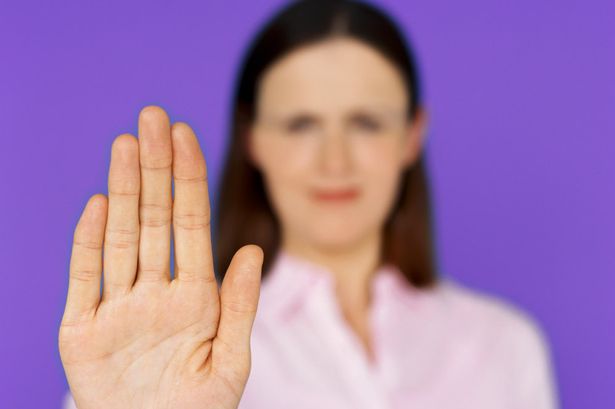
Rashes on children's palms: causes, symptoms, how to get rid of the disease
A rash on the palms of a child should be a cause for concern for the mother. There are many reasons that cause its appearance. To find out the nature, you will need to consult a pediatrician.
Various circumstances can provoke skin sores.
Factors that provoke rashes
The appearance of a rash on the palms of a child that itches can be caused by various factors. In infants, similar symptoms appear due to allergies, especially during the period of introducing complementary foods. Sometimes sores, bubbles and blisters signal serious pathologies.
Allergic reaction
The formation of hives on the palms indicates that the baby has been in contact with an allergen or has eaten a prohibited product.
Various foods and substances can cause allergies:
- sweets;
- dairy products;
- animal hair;
- medications;
- dust;
- washing powder or conditioners.
On a note. Allergy is manifested not only by a bright red rash on the palms. Additionally, there is itching, runny nose, sneezing and other allergic symptoms.
Contact dermatitis
This is another type of allergic reaction, since contact dermatitis is triggered by contact with an allergen. The rash appears in the form of red formations. Bubbles and blisters may occur. The skin constantly itches, pimples burst, forming wounds and cracks.
In addition to the allergen, contact dermatitis is caused by problems with the digestive and circulatory systems, and various infections.
Skin infection by parasites
Parasites and insects often provoke the appearance of rashes on the hands. Small palms may develop an allergic rash from the bites of wasps, bees, and mosquitoes.
A mite can cause severe itching and the appearance of a rash; it settles on the palms, in the folds of the skin, and on the genitals. The disease is called scabies.
On a note. Do not confuse the rash with numerous mosquito bites, fleas and jellyfish stings. Insect marks may swell and the child will scratch them.
Viral infection
Rashes are a sign of developing infections. Along with the rash, symptoms characteristic of acute respiratory infections appear. The most common infectious diseases:
- Chickenpox. Small spots form, which gradually transform into bubbles no larger than 5 mm in size. After a week, the pimples will disappear, leaving thin crusts.
- Measles. Additionally, there are signs of infection (fever, cough, lethargy). The first sores appear on the head, then move to the palms, feet, and torso.
- Coxsackie virus. A special type of infection, one of the symptoms of which is a rash.
- Rubella. The first rashes form on the outer side of the palm, the folds of the arms and legs. The sores are thick and small. Accompanied by signs of intoxication.
- Scarlet fever. First, the throat begins to hurt, like a sore throat, and on the 2nd day small rashes appear.
A common cause of rash is rubella
It is impossible to manage infections without medical care, since incorrect diagnosis and treatment can provoke the development of complications.
Overheating, which causes sweating
A simple lack of hygiene can cause skin rashes. If you do not wash your baby in a timely and regular manner, sweat rash initially appears. If the baby scratches the sores, infections and bacteria can get inside, which can cause the formation of pustules.
For your information. Excessive wrapping of the baby can often trigger the formation of heat rash.
Psoriasis and eczema
Eczema is a pathology of a neuro-allergic nature. Initially, small blisters may appear that itch. Gradually they fill with pus. Typically, eczema is accompanied by the development of a bacterial infection.
Gradually, with eczema, instead of rashes, large areas of peeling appear
The development of psoriasis can cause rashes. The pathology, which is characterized by damage to the dermis and is chronic, is not infectious in nature. A small rash on the child's palms and soles is very itchy. As a result of scratching, plaques form.
Other causes of rash
Often the cause of rashes is problems with the functioning of some internal systems of the body. If the circulatory system malfunctions, hemorrhagic rashes may appear on the arms, hands, and feet. The reason is the destruction of blood vessels and capillaries. Red blood cells leak through the skin, causing dark spots to appear on the surface of the epidermis.
On a note. This rash on the child’s palms and other parts of the body does not cause discomfort, but it signals possible pathologies.
Types of rashes
Rash on a child's chin - causes of red pimples
The appearance of a rash on the palms does not go unnoticed by parents. The rashes may differ from each other in appearance:
- Reddish blisters. Most often, a colorless liquid collects under the top layer of the epidermis.
- Pimples. These are nodules hidden in the skin.
- Pustules. Inside are filled with purulent fluid.
- Blisters. They rise above the skin level, are rough on top and dense in structure.
- Ulcers and erosions. Damage to the skin, which is characterized by various discharges.
- Stains. Accumulations at the skin level that differ in color from it.
If crusts begin to form at the site of the rash, this is a signal of gradual recovery.
What to do with a child's rash
Any rash on the palms, feet, elbows, and fingertips is a signal for parents. Consultation with a pediatrician will help. Only an experienced specialist will correctly diagnose the cause of the problem and prescribe appropriate treatment.
It is not necessary to see a doctor if the mother understands for sure that the rash is a heat rash or a known allergy.
Important points before the pediatrician arrives
If a rash appears in a child, other possible symptoms should be diagnosed and reported to the doctor.
Possible additional signs of disease:
- temperature;
- runny nose;
- nausea and vomiting;
- cough;
- pain;
- lethargy;
- loss of appetite.
If a rash appears on the palms of your hands, you should check your baby's entire body and mouth, especially the feet and legs. Until the cause is determined, a child with a rash is isolated from others.
Need for medical attention
Call an ambulance if a child has a red rash on the palms of their hands accompanied by other symptoms:
- high temperature;
- vomiting or nausea;
- severe itching;
- lethargy and loss of appetite.
If there are no severe accompanying symptoms, but the causes and nature of the rash are not clear, then a trip to the pediatrician is required.
Diagnosis and treatment
If a rash appears on the palms, feet and other associated symptoms, only a medical institution will carry out a high-quality diagnosis. Through a series of tests, the true cause of the problem can be identified.
The first diagnostic step is to examine the body for other rashes.
Initially, the baby will be examined by a doctor. General blood and urine tests are prescribed. If necessary, the child is referred to a dermatologist, who will write out directions for specific tests.
Prevention
The likelihood of a rash appearing in a child under one year old can be minimized by taking simple preventive measures:
- Proper balanced diet, which should be free of allergens.
- Be sure to stick to your daily routine.
- From the first days of life, you need to teach your child to wash himself, wash his hands after going outside, and before eating.
- All family members, including a newborn, should have their own personal hygiene items.
- Contact with unfamiliar animals is not allowed.
- In cold weather, the use of mittens is mandatory.
Prevention is the best way to deal with possible problems
Most often, the cause of a rash on the feet and palms of a child is an allergy, but other factors should not be excluded. Avoiding problems is much easier than treating them later.
If the rash is caused by a disease, and its appearance is accompanied by other symptoms (fever, runny nose, disruption of the digestive system), then you should not hesitate.
In this case, you cannot do without medical help.
Source: https://kpoxa.info/zdorovie-pitanie/syp-na-ladonyakh-rebenka.html
Diseases of internal organs
Disturbances in the functioning of the digestive system can provoke the appearance of such an unpleasant symptom as rashes on the palms. Functional failures can lead to the fact that decay products and toxins leave the body not naturally with feces and urine, but through the skin. Watery pimples on the palms can be a symptom of gastritis, dysbacteriosis, and pancreatic diseases.
In some cases, rashes occur due to an unhealthy diet. An unbalanced diet, abuse of processed foods, fatty, sweet and salty foods can also cause the formation of small formations on the palms.
Urticaria on the hands of children and adults
Hives on the hands are one of the manifestations of an allergic reaction in response to exposure to foreign substances (pollen, dust, chemicals, medications, animal hair, etc.). Pathology is a type of dermatosis.
One in four people will experience symptoms of urticaria during their lifetime. Young people under 40 years of age, including children and adolescents, are most often affected.
In almost half of the cases, urticaria is combined with angioedema and can be life-threatening.
What is urticaria?
Urticaria is a pathology characterized by the appearance of itchy blisters up to several centimeters in size on the skin. This is the most common form of allergy after bronchial asthma and drug allergies.
Causes of the disease
The cause of the development of acute urticaria on the palms and fingers in adults and children is repeated contact with the allergen after preliminary sensitization.
https://www.youtube.com/watch?v=mJ1h_MGOGi4
Provoking factors include:
- autoimmune disorders;
- physical factors (weather changes, exposure to cold, insolation);
- infectious diseases;
- a history of other allergic diseases (Quincke's edema, asthma, rhinitis, conjunctivitis);
- hormonal imbalance;
- excessive physical activity;
- the presence of concomitant somatic diseases (serum sickness, cryoglobulinemia, helminthiasis, sinusitis, inflammation of the tonsils, helicobacteriosis, lymphocytic leukemia, thyroid pathology and systemic diseases);
- contact with other people's pets;
- insect, arachnid and snake bites;
- stress.
Hives-like rashes are caused by the following allergens:
- Animal poisons. Most often, allergies develop after being bitten by spiders, mosquitoes, bees and wasps. In this case, the rash may disappear only the next day.
- Latex. Gloves and clothing are made from this material.
- Household cleaners and detergents (washing powders, window and dishwashing detergents).
- Sun rays.
- Water (in extremely rare cases).
- Food (citrus fruits, nuts, honey, eggs, strawberries, seafood, chocolate).
- Medicines, including immunobiological drugs (NSAIDs, antibiotics, serums, vaccines).
- Plants, especially pollen.
- Dust.
- Animal fur.
- Particles of dead insects.
- Waste products of insects and mites.
- Mold.
- Low temperature.
Most often, urticaria appears due to direct (skin) contact with an allergen or its ingestion (food, airborne, injection).
Urticaria on the hands occurs as an immune response
With type 1 reaction, urticaria occurs quickly within a few minutes (up to half an hour). This reaction is called immediate. Blisters appear in areas of damage to the papillary layer of skin. This is preceded by edema, which occurs against the background of increased vascular permeability and dilation of capillaries. Sometimes the disease can occur as a type 2 or 3 allergic reaction.
Small red rash
The main sign of urticaria is the presence of a red or pink urticaria on the hands or forearms. Not only the upper extremities can be affected, but also the torso, face, neck and legs. Urticaria rashes disappear without a trace within 24 hours. No areas of pigmentation remain.
Peeling
Peeling is a rare symptom of hives. It can occur if an infection occurs and dermatitis develops against the background of severe itching.
Redness
The skin around the rash becomes red. The reason is vasodilation. Skin hyperemia may be the first symptom of an allergy.
Blisters
Blisters are bubbles filled with fluid. They are round in shape, rise above the skin and resemble the rash that appears when stung by nettles. Blisters range in size from 2-3 mm to 10-15 cm (with giant urticaria).
They have clear boundaries and sometimes merge with each other. Their distinctive feature is their temporary disappearance when the skin is pressed or stretched. The severity of urticaria is judged by the number and speed of the appearance of blisters.
Cracks
Not typical for urticaria. Cracks appear due to scratching and dry skin.
Ulcers
The appearance of ulcers on the skin is possible when tissue suppurates as a result of a bacterial infection.
Features in children
In young children (up to 2-3 years old), the acute form of the disease is diagnosed predominantly. In children under one year of age, this pathology often causes hospitalization. Urticaria in a child is often combined with atopic dermatitis.
Features of the rash in children:
- instant appearance;
- disappearance within the first 2 hours (sometimes lasts up to 2 days);
- formation of large bubbles;
- irregular shape of skin swelling.
Treatment options
Treatment begins after the doctor makes a diagnosis. This will require a survey and examination of the patient, general and biochemical blood tests, a urine test, skin allergy tests, and a blood test for immunoglobulins.
The prescribed treatment will be aimed at solving the following problems:
- elimination of symptoms of the disease (itching, rash, swelling, redness);
- prevention of complications;
- reduction of allergic reaction;
- eliminating risk factors;
- removing the allergen from the body;
- desensitization (reducing the body's sensitivity to foreign substances).
Treatment includes:
- use of local and systemic medications;
- cessation of exposure to the allergen;
- physiotherapy;
- use of traditional medicine;
- allergen-specific therapy;
- dieting.
What to do first and what to refuse?
First you need to assess the patient's condition. If hives are a symptom of anaphylaxis, emergency treatment may be required.
Necessary:
- call an ambulance;
- administer prednisolone and adrenaline (after the arrival of specialists);
- stop contact with the allergen (clean the mouth, rinse the stomach, clean the skin, remove the source of the poison).
If breathing and heartbeat stop, resuscitation measures are required . Before the doctor arrives, you must stop taking medications (with the exception of antihistamines). It is also not recommended to treat the skin with solutions and ointments. Self-medication can be harmful.
Diet
Patients are advised to exclude from the menu citrus fruits, red berries, honey, nuts, eggs, chocolate, alcoholic and carbonated drinks, sweets, spicy foods, extractives, spices, mushrooms, sauces, foods with a large number of food additives, pineapples, legumes, tea and coffee. Peeling, boiling and pre-freezing help reduce the allergenicity of foods. Patients can eat porridge with water, lean soups, boiled vegetables and meat, mashed potatoes, baked apples, olive oil, white bread and natural dairy products.
Medicines for urticaria
When prescribing medications, the doctor must take into account contraindications, allergy history and the patient’s age. In the case of anaphylaxis, medications may be given by injection.
Tablets and ointments
For urticaria the following are prescribed:
- Antiallergic drugs (H1-histamine blockers). These include Allegra, Zodak, Zirtec, Erius, Cetrin, Claritin, Loratadine, Desloratadine, Suprastin, Suprastinex, Ebastine, Kestin, Tavegil. For children, the medicine can be given in the form of syrup.
- Sorbents (Polysorb, activated carbon, Laktofiltrum, Polyphepam, Polysorb MP, Enterosgel).
- Systemic corticosteroids (Metypred, Dexamethasone, Prednisolone). Indicated when antihistamines are ineffective.
- Immunosuppressants. Indicated for autoimmune urticaria.
- Antiallergic ointments and gels (Fenistil, Dimetinden, Psilo-Balm).
- Hormonal ointments, creams and gels (Momat, Uniderm, Advantan, Lorinden A, Sinaflan).
Folk remedies
For urticaria, folk remedies are ineffective. First you need to identify the allergen. Many patients are helped by such remedies as nettle infusion, dill juice, wild rosemary infusion for baths and clover juice.
Viral diseases
The most common viral disease, which is characterized by the appearance of blistering rashes, is herpes. Blistering rashes mainly occur on the lips, nose, and mucous membranes of the genitals, but with severe immunodeficiency they can also be localized on the palms.
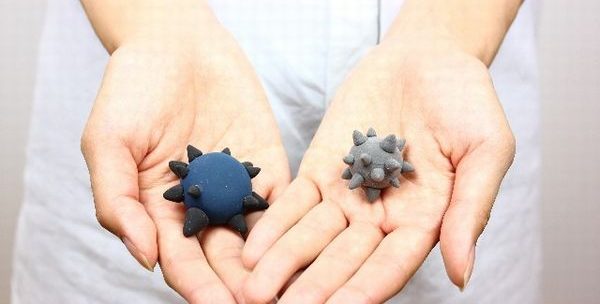
Enterovirus infections manifest themselves in a similar way, which, in addition to intestinal disorders, cause a small reddish rash on various parts of the body. Pimples that have a viral etiology do not itch, but even the slightest touch to them causes pain in the patient. With enterovirus, body temperature may rise to subfebrile levels.
Symptoms
Urticaria on the hands is characterized by two development mechanisms - immune or non-immune.
In the first case, the immune response to the penetration of an allergen into the body is the production of a protective substance - immunoglobulin E. As a result of accumulation, it interacts with special cells, which contain heparin, histamine and other active components.
The next time the allergen enters the body, it combines with antibodies that combine with mast cells. Against this background, there is a release of histamine, which manifests itself in the form of swelling, redness and vasodilatation.
On this topic
- Hives
What are the dangers of mechanical urticaria?
- Inna Viktorovna Zhikhoreva
- August 17, 2020
Such a reaction is immediate when the manifestation of the disease occurs within minutes from the moment of contact with the allergen.
Among the main symptoms of the disease are the formation of blisters on the skin of the upper extremities. Against this background, itching and increased body temperature may occur. In more severe cases, hives can cause swelling. The most dangerous condition is considered to be Quincke's edema.
Itching and burning cause irritability in the patient, as a result of which this condition may be accompanied by:
- headaches ;
- general weakness;
- insomnia;
- disorder .
Urticaria makes itself felt with the following manifestations:
- Redness. If the hands were affected, then this is the first symptom of the disease. The red rash is usually accompanied by painful itching.
- Peeling. In most cases, individual rashes disappear on their own after a few hours. If the blisters do not go away longer than the prescribed period, then we can talk about another pathology, which in its symptoms is similar to urticaria.
- Small rash with redness. An insect bite can last up to two days.
- Blisters. This is the main symptom of hives. The rashes can vary in size and are often accompanied by severe itching. This condition is often accompanied by fever and swelling.
- Cracks. Scratching watery blisters disrupts their integrity, causing them to burst. Painful wounds form at this site.
- Ulcers. More severe forms of hives can lead to weeping sores on the hands. This is one of the most serious signs that requires immediate medical attention.
With serious damage to the skin, the risk of infection entering the skin increases significantly.
Allergic reaction
In this case, small pimples on the palms can be perceived as the body’s response to contact with an irritant. Anything can be an allergen, but most often such a reaction occurs when using washing powders, detergents, and cosmetic products.
Rashes on the hands are sometimes found in children suffering from diathesis. Among food allergens, the most common are honey, nuts, seafood, egg yolk, citrus fruits, chocolate, etc. Rash on the palms caused by food allergies is always accompanied by severe itching. Pimples look like small translucent blisters that can unite into a single formation, rapidly spreading to other parts of the body.

Urticaria on the hands: causes, symptoms, treatment methods
Hives on the hands are one of the manifestations of an allergic reaction in response to exposure to foreign substances (pollen, dust, chemicals, medications, animal hair, etc.). Pathology is a type of dermatosis.
One in four people will experience symptoms of urticaria during their lifetime. Young people under 40 years of age, including children and adolescents, are most often affected.
In almost half of the cases, urticaria is combined with angioedema and can be life-threatening.
Causes
Urticaria is an acute inflammation of the connective tissue of the skin. Rashes on the fingers are called urticaria. The disease occurs in 30% of people, regardless of age and gender. More often, malaise develops in women at the onset of menopause due to hormonal changes in the body.
Acute form
The rash appears quickly, lasts from 1–2 hours to 15 days, and disappears suddenly. The acute form can be stopped only with timely treatment.
Causes of urticaria on the hands:
- Contact with an allergen . The rash occurs immediately after interaction with substances and animals. It can be caused by insect bites or household chemicals (shampoos, paints, detergents).
- Taking medications . Allergic rashes tend to be caused by antibiotics, vaccines, painkillers, and sulfonamides.
- Eating certain foods . These are nuts, seafood, honey, strawberries, citrus fruits.
Chronic form
When the allergen is not identified, idiopathic urticaria develops. It is characterized by a protracted course caused by the following physical factors:
- excessive compression;
- friction;
- scratches;
- hypothermia;
- exposure to sunlight.
Autoimmune urticaria takes a chronic form, which develops for several reasons:
- Pathologies of the digestive system. Inflammatory processes in the liver are accompanied by delayed destruction of histamine. Its excess provokes an allergic skin reaction.
- Systemic diseases. These include rheumatoid arthritis, lupus erythematosus.
- Foci of chronic infection of any location. This can be tonsillitis, adnexitis, and in children - adenoid growths.
- Problems with the thyroid gland.
- Sarcoidosis of the lungs.
- Lymphoma.
- Tumors of the kidneys and rectum.
- Parasitic infestations.
In chronic urticaria, activation of mast cells is caused by emotional stress, alcohol, and trauma.
New directions
Today, scientists are actively researching alternative groups of drugs for the treatment of urticaria, including androgenic hormones and antidepressants, Methotrexate.
There is a question about the advisability of phototherapy and plasmapheresis if urticaria is caused by exposure to solar radiation.
The use of a new category of substances with the symbol MAT allows selective action on target molecules, which makes them a good tool in the treatment of immune-mediated pathologies.
The drug Omalizumab is effective in the treatment of chronic urticaria. It was previously used to treat advanced asthma. Today, scientists are still searching for new biological compounds that could effectively eliminate the clinical manifestations of urticaria.
Often the patient has to deal with the only episode of acute urticaria in his life. It rarely becomes chronic, but even if it does, spontaneous remission occurs in 50% of cases. Anaphylactic reactions are considered unfavorable. Patients with cold urticaria should avoid swimming in ice water. This may pose a risk to their health.
Symptoms
A characteristic symptom of urticaria is a sudden onset with rapid disappearance. Elements of allergic rashes are located on the back, stomach or head. Less commonly they appear on the palms after contact with household chemicals or animal hair. The rash may appear on the forearms or hands.
Blisters with a pale red tint appear on the reddened skin. The size of the rash varies from a pinhead to several square centimeters.
Hands covered with a rash itch very much, as if stung by nettles. If the cause of urticaria is not removed, a relapse occurs. Spots in chronic urticaria change localization, spreading to the face and genitals.
The course of allergic rashes can be complicated by a dangerous condition - Quincke's edema. In this case, the deep layers of the skin are involved in the process. The greatest danger is swelling of the throat, which makes it difficult for a person to breathe. If the lips and tongue are swollen, shortness of breath suddenly appears, then the patient needs emergency hospitalization.
Medications
How to treat hives on the hands with medications? First of all, the allergist prescribes antihistamines, corticosteroids, and restores the intestinal microflora. Recommends adsorbent preparations (activated carbon), medications to support the liver.
External products help to quickly tidy up the skin and get rid of itching:
- Gistan;
- Flucinar;
- Nezulin;
- Advantan;
- Lorinden S;
- Sinaflan;
- Elokom and others.
Many external remedies contain hormones; trust the treatment of urticaria only to a doctor!
Diagnostics
Anamnesis helps to identify the cause of the allergy. If hives appear on the palms, you need to determine what substance the patient’s hands came into contact with. During the examination, attention is paid to the nature of the rash, the duration of the blisters, the presence of fever, and swelling of the joints.
Source: https://gidroz.ru/kozha/krapivnica-na-rukah.html
Skin pathologies
The first thing every dermatologist will suspect when he hears a complaint about pimples is scabies. On the skin of the palms, this disease manifests itself as a small reddish rash, and under the upper layers of the epidermis, grayish stripes are noticeable - the passages of the scabies mite. The parasite most often penetrates the skin between the fingers, since it is in this place that it is very tender.
Among the skin diseases that occur with rashes on the skin of the palms, it is worth noting fungus. It usually affects the nail plate, but in advanced cases it can spread to the hands. Both scabies and fungus are contagious diseases, so tactile contact with people suffering from these diseases should be avoided.
Urticaria on the hands: photos in children and adults, treatment, causes and symptoms
The condition and appearance of the skin can tell a lot about a person’s well-being and health.
Hidden internal diseases and pathological conditions are manifested by various skin problems. One of these problems is an unpleasant disease - urticaria on the hands.
Bright spots are noticeable to others, which brings moral discomfort, especially to the fair sex. The painful itching is difficult for children to endure. The disease requires immediate treatment. And for this it is necessary to correctly determine which factors served as the trigger for the development of the disease.
Causes of urticaria on the hands
Hives are a condition that can be caused by many causes.
The main role in the mechanism of the appearance of a rash in the form of urticaria on the hands belongs to histamine. Histamine is a biologically active substance that is found in the form of granules inside white blood cells (mast cells).
Under the influence of various substances that enter the body or external factors, histamine is released by mast cells. Free histamine causes swelling and inflammation of the tissue at the site of release, and the formation of blisters on the skin.
There are 2 main pathways for the release of histamine from mast cells, which trigger the onset of urticaria:
Immune variant of the development of urticaria
Underlies most allergic reactions.
When an allergen (antigen) enters the body, the immune system produces special proteins - immunoglobulins (antibodies). Antibodies attach to antigens to destroy them or stop their reproduction.
The resulting complex, in turn, attaches to mast cells and provokes the release of histamine. Symptoms of urticaria in this case occur quickly, within 1-2 hours after contact with the allergen.
Urticaria on the hands occurs as an immune response:
After eating certain foods (citrus fruits, chocolate, nuts, fish, egg whites, red berries). After an insect bite (mosquitoes, bees). After contact with certain substances and materials (household chemicals, cosmetics, metal jewelry, synthetic clothing).
After inhalation of volatile gaseous substances (perfume, aerosols), dust, plant pollen. After vaccination. After exposure to external factors (cold, heat, water, ultraviolet radiation, friction, vibration). After stressful situations, physical activity.
Non-immune variant of the development of urticaria
In this case, the release of histamine occurs without the participation of immunoglobulins. The pathogenic substance directly acts on mast cells, bypassing the complex chains of antigen-antibody bonds.
Some medications have this effect (for example, aspirin, some anti-inflammatory drugs, antibiotics).
Find out more
Urticaria as a symptom of other diseases
In some cases, urticaria on the hands does not occur as an independent disease, but as an external manifestation of hidden internal pathologies in the body:
- infectious and viral diseases;
- fungal infections; intestinal disorders;
- changes in hormonal levels;
- thyroid dysfunction;
- oncology; autoimmune diseases.
The most typical causes for urticaria on the hands are physical and nutritional.
Important
Hives on the hands are not contagious. The disease is not transmitted from person to person through a handshake or other household means.
Symptoms of urticaria on the hands
All types of urticaria are united by a unity of symptoms. What urticaria looks like on the hands is shown in the photo.
The primary pathological element is a skin blister, reminiscent of a burn from nettle leaves. This is where the name of the disease comes from. Initially, a small transparent bubble appears on the skin of the hands. Then it increases in size, and a pink or red edging forms around it.
The initial manifestations of urticaria are located on the hands, fingers, and palms. Further, the number of blisters grows exponentially. The rash extends to the area of the forearms, to the elbow.
The skin in the area of the rash becomes inflamed, red, and swollen. Swelling of the surrounding tissues affects the deeper layers of the skin and compresses the nerve endings. As a result, the blisters are accompanied by another distinctive sign of urticaria - itching.
The pain is moderate, but its constant monotonous nature causes a person a lot of suffering. Itching worsens at night, interferes with quality sleep, and can even cause emotional distress.
Urticaria on the hands occurs spontaneously and goes away without a trace. Lasts less than 6 weeks and rarely develops into a chronic stage.
Features of urticaria on the hands of children
Hives on the hands of children are quite common. In most cases, the disease goes away on its own and does not require serious treatment. Nevertheless, it is imperative to show the child to a pediatrician.
The most common cause of hives in children is food allergies. To quickly determine which food product a reaction occurred to, you need to keep a food diary. New treats should be offered to the child in small quantities, no more than one type per day. A nursing mother should also adhere to a hypoallergenic diet during lactation.
A child may have an allergic reaction to pet fur. If this happens, it is better to remove the pet from the house for a while. Perhaps as you grow older, the situation will change.
Another cause of urticaria in children is post-vaccination complications. Characteristic rashes may appear as a reaction to one of the components of the vaccine.
Important.
Children should not be vaccinated at home. Urticaria can be accompanied not only by local edema, but also by general angioedema (Quincke's edema). Only immediate medical attention will help avoid death.
Urticaria on the hands of a child and an adult, as can be seen from the photo, has similar symptoms and prerequisites for treatment.
The doctor chooses the treatment methods taking into account the child’s age and the severity of the disease. To relieve itching, cooling creams and ointments may be prescribed. Bathing in a bath with the addition of decoctions of medicinal herbs (chamomile, string, calendula) helps well. Also, it is necessary to ensure that the child does not scratch the blisters and does not introduce additional infection into the wounds.
Treatment of urticaria on the hands
Considering the multifactorial pathogenesis of urticaria on the hands, only a doctor can decide how to treat the disease.
The standard treatment regimen includes the following steps:
Visual examination, medical history, determination of the cause of the disease. Eliminate contact with the provoking factor or substance. Cleansing the body of allergens. For this purpose, sorbent preparations are used.
Relieving adverse symptoms with medications. Medicines are selected by trial method, according to the principle of gradually enhancing the current effect in the following sequence:
- Il generation antihistamines in minimal dosage;
- Il generation antihistamines in increased dosage (maximum 4 times);
- combining antihistamines of different generations;
- hormonal drugs; immunosuppressants.
Carrying out diagnostic measures to identify other chronic diseases and their treatment. Teaching the patient preventive measures to prevent relapses.
Prevention of urticaria on the hands
For anyone who has experienced allergies at least once in their life, it is very important to know how to prevent new attacks. Urticaria on the hands is especially dangerous during pregnancy or childhood, because drug treatment during this period may be contraindicated.
To protect yourself from illness, you must follow the following rules:
Control food preferences. Avoid foods that cause allergy episodes. Limit visits to public catering establishments; when choosing products in a store, carefully study the composition. Use hypoallergenic cosmetics.
Before dyeing hair, performing cosmetic procedures and injections, conduct skin tests. Avoid prolonged exposure to sun or frost. Protect your hands with gloves or sunscreen. Do not visit the solarium and bathhouse. Avoid trips to nature during the flowering period of meadow plants.
Rinse your nose with saline solutions several times a day. Do wet cleaning of the house daily. Take only those medications that have been approved in advance by your doctor. Do not wear tight clothing.
Give preference to natural fabrics. Lead a healthy lifestyle. Stop smoking and drinking alcohol.
The skin is the first level of protection of the body from the negative influence of the environment. That is why, when in contact with harmful substances, the skin of the hands suffers first. If symptoms of hives appear on the hands and fingers, do not panic.
You need to remember what you did, ate, drank in the last 24 hours and quickly eliminate the cause of the illness. And medications carefully selected by the doctor will help you survive several days of exacerbation without unnecessary physical and mental suffering.
Source: https://www.dermatit.net/krapivnica/krapivnitsa-na-rukah/
Other causes of acne on hands
Rashes on the palms also occur due to insect bites. In case of an allergic reaction to substances that bees, mosquitoes and other insects inject into the skin during an attack, a small, swollen rash appears around the bite site. Children are predominantly prone to such allergies.
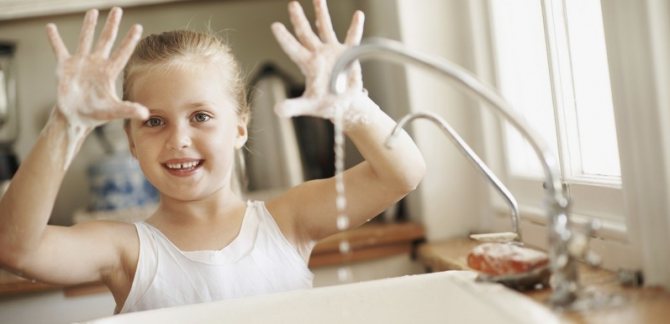
By the way, pimples on the palms of a child can be caused by neglecting the rules of basic hygiene. Children often injure the skin of their hands and rarely wash them with soap - this leads to the formation of a rash.
Classification of the disease by forms and types
Urticaria has two forms - acute and chronic.
They differ from each other in the regularity of their appearance and the course of the disease.
- Acute urticaria develops within a few hours after contact with the allergen, and pronounced symptoms appear: rash, itching, fever. With proper treatment, symptoms of the disease can be eliminated within 2 weeks.
- Chronic occurs in the absence of acute treatment. In this case, symptoms of the disease may appear for reasons unrelated to an allergic reaction to a specific product or physical impact. In some cases, the rash does not go away from the body for months. Chronic urticaria on the fingers looks less noticeable and is characterized by the absence of severe itching.
There are many more types of urticaria. This is due to many possible reasons for the development of the disease, for which the following types of urticaria are distinguished:
- Medicinal, where medications act as an irritant.
- Contact, when the rash appeared after touching the skin of the hands to the allergen.
- Food - if the product that caused the rash was ingested.
- Dermographic, when symptoms of the disease appeared after squeezing the limbs with tight clothing.
- Solar is the same photodermatosis. Urticaria after sunbathing is one of the rare forms of its manifestation.
- Thermal, or cold, occurs after the ambient temperature drops.
- Traumatic. The cause is injury or skin disease.
- Miliaria is a reaction to your own sweat, which appears too abundantly on the surface of the skin.
In some cases, you can immediately determine why hives appeared on the forearms and wrists. In another situation, the help of a specialist will be required to accurately identify the irritant.
Blisters on hands and feet
Sometimes small blisters appear on the palms and soles of the feet at the same time. In 99% of cases, their cause is infection with one of the types of enterovirus infection. The most common example is the Coxsackie virus. The pathogen multiplies in the gastrointestinal tract. Its danger lies in its ability to cause aseptic meningitis. If a person has suffered this infection once, he subsequently develops strong immunity.
Bubbles that appear on the palms and soles are filled with clear liquid. They don't itch, but they are painful. Patients infected with the Coxsackie virus develop small ulcerations in the mouth.
Let's look at the most common causes of rashes
Pemphigoid
Chronic skin disease of an autoimmune nature. Mainly affects older people. The symptoms are similar to some forms of pemphigus. Manifests itself as tense bubbles of varying sizes.
Depending on the location of the rash, several forms of the disease are distinguished:
- Bullous. The rash is located in the groin area, armpits, inner thighs, palms and soles.
- Scar-like. Affects mucous membranes.
- Gestational. Develops during pregnancy and is localized in the upper part of the body.
Dermatomyositis
Pathology of connective tissue, in which smooth and striated muscle fibers are affected and motor dysfunction develops.
The most common symptoms include:
- muscle weakness;
- strong increase in temperature;
- rash of the erythema type;
- visceral symptoms.
Treatment is based on hormonal therapy. In advanced cases, the disease has an unfavorable prognosis.
Herpes
It manifests itself as a vesicular rash on the mucous membranes and lips, also in the area of the external genitalia.
Most often caused by herpes simplex virus type 1, less often 2. Symptoms:
- It starts with redness and burning.
- Later, a tubercle forms and turns into a vesicle.
- At the last stage it dries out and falls off.
Treatment is carried out with a drug based on acyclovir, valacyclovir or famciclovir.
After entering the body, the virus remains there forever and is characterized by a relapsing course. Transmitted by contact.
Scabies
The causative agent of the disease is the scabies mite. Transmitted through the use of common hygiene items. The incubation period lasts from hours to weeks, most often symptoms appear on the second day after infection.
These include:
- skin itching, worse at night;
- rash;
- subtle grayish stripes are traces of passages.
Due to severe itching and scratching, infection may occur. The main medications are sulfur ointment, permethrin and others.
A skin disease in which inflammation develops due to blockage of the mouth of the hair follicle. Most often appears in adolescents, risk factors: hormonal disorder, stress. It can develop with chronic diseases and infections.
There are many varieties that appear in the form of:
- open and closed comedones;
- papular rash;
- nodules;
- pustules
For treatment, a local remedy is used that prevents the formation of comedones, reduces sebum production, and has an anti-inflammatory effect.
Candidiasis
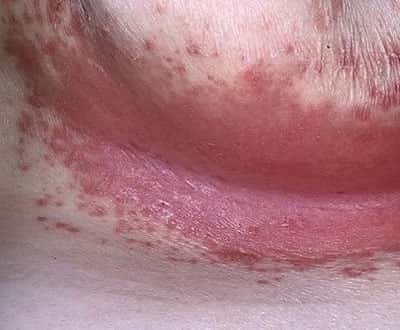
The disease is caused by the proliferation of fungi of the genus Candida, which are constantly present in the human body. The trigger for activation of the flora is a decrease in local immunity caused by poor hygiene, taking antibiotics or other factors.
There is no rash as such with thrush, but the surface of the skin takes on a reddish tint and is very itchy, as are the mucous membranes. The most common localization is the oral cavity, external and internal genital organs. A characteristic symptom is a white, cheesy discharge with a sour odor.
A type of skin and dermatological diseases caused by a virus, manifested by formations with a depression in the center. It does not pose a threat to health, but causes inconvenience and is a cosmetic defect.
The rashes are localized on the neck, genital area, and armpits. After recovery, immunity is not developed and re-infection is possible. There is no specific therapy
Eczema
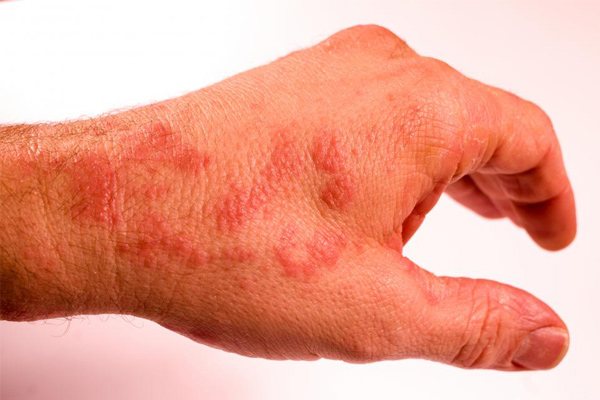
Also called allergic dermatitis. It is a skin pathology manifested in the form of various rashes provoked by exposure to an allergen. Mostly such a reaction is caused by food products, less often by plant pollen, household chemicals, and materials. The following stages of the disease are distinguished:
- Erythematous. Accompanied by itching and redness of the skin.
- Papulovesicular. Characterized by rashes in the form of papules filled with liquid.
- Getting wet. The blisters burst and release serous fluid.
- Cortical. dry out and become covered with a light yellow crust.
Treatment includes examination by a dermatologist, blood tests and allergen tests, and diet. Prevention – avoiding exposure to allergens.
Demodex
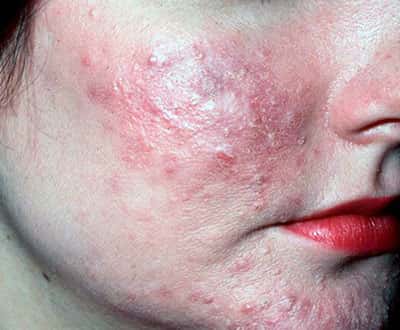
A skin disease that develops as a result of mite infestation. It begins mainly in adolescence and is accompanied by the formation of acne, pustules and red spots on the face. The affected areas are moist and smell unpleasant.
We invite you to familiarize yourself with Burgundy dots on the body
Diagnosis is carried out by microscopic examination. Treatment is carried out with sulfur ointment and a special skin care regimen. Complications include the development of other dermatological diseases: dermatitis, acne, rosacea.
HIV rash
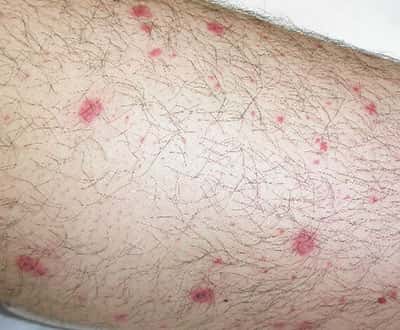
The rash is the first sign of infection and develops in the first weeks after infection. Often leads to the appearance of various pimples and blemishes. The intensity may vary. If the rash is a consequence of the use of antiviral drugs, it will appear in the form of areas raised above the skin (drug-induced dermatitis).
Most often, HIV rashes appear on the shoulders, chest, face, abdomen, or arms. Please note that the rash is not a source of infection.
The general name for several infectious diseases accompanied by mental pathologies against the background of severe fever. The cause is infection with bacteria - intracellular parasites. Carried by lice.
Symptoms:
- heat;
- intoxication;
- facial redness and conjunctivitis;
- decrease in pressure;
- myocarditis;
- redness of the mucous membranes of the mouth;
- increased heart rate.
When the skin is touched, hemorrhages remain. Antibiotics are used as well as medications to reduce symptoms.
Toxic shock
A systemic disease that is life-threatening. The causes of development are infection with staphylococcus and streptococcus.
It manifests itself as redness of the oral mucosa, a rash in the armpits and groin, shaped like a burn, a rapid increase in body temperature, the appearance of cold symptoms, low blood pressure, and dizziness.
In later stages - skin necrosis, blood poisoning, peeling of skin tissue on the soles of the hands and feet, blepharitis, conjunctivitis.
Prickly heat
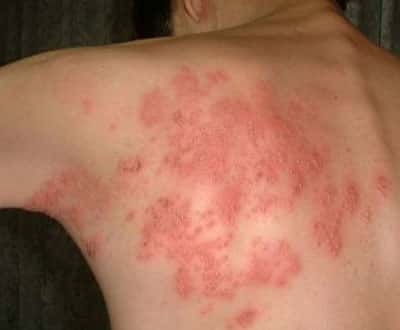
It is a type of dermatitis that occurs due to excessive sweating or skin irritation. The main difference between the disease and similar ones is the location of the rashes: with prickly heat, they are localized in places of greatest sweating - in the folds, armpits, and on the back.
Clinically manifested by a small rash of pink or reddish color, accompanied by itching.
A viral disease transmitted from person to person and characterized by general intoxication and rashes. Today, smallpox is considered defeated thanks to vaccination.
First, the general symptoms of infectious diseases develop - fever, aches, chills. The disease is often accompanied by signs of nausea and vomiting. On the 4th day a rash appears, transforming into papules and blisters that burst and leave marks.
Syphilis
A disease caused by Treponema pallidum and manifests itself in the form of hard chancre throughout the body. It is transmitted sexually and through contact with contaminated human body fluids.
There is specific treatment that often leads to complete recovery, but as the disease progresses, it affects internal organs, including the nervous system, and can lead to death.
Cold allergy
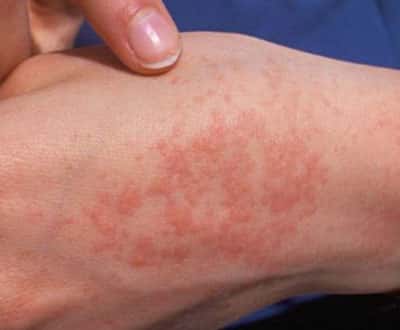
Exposure is characterized as a special reaction of the immune system, the cause of which is specific processes in the body. Most often these include: immune disorders, autoimmune and oncological diseases, chronic processes, infections.
Rashes on the back
Bubbles on the inside of the hand are almost invisible to others, but pimples on the outside of the palm cause not only physical, but also psychological discomfort. On the back side, small blisters usually occur when dermatitis worsens.
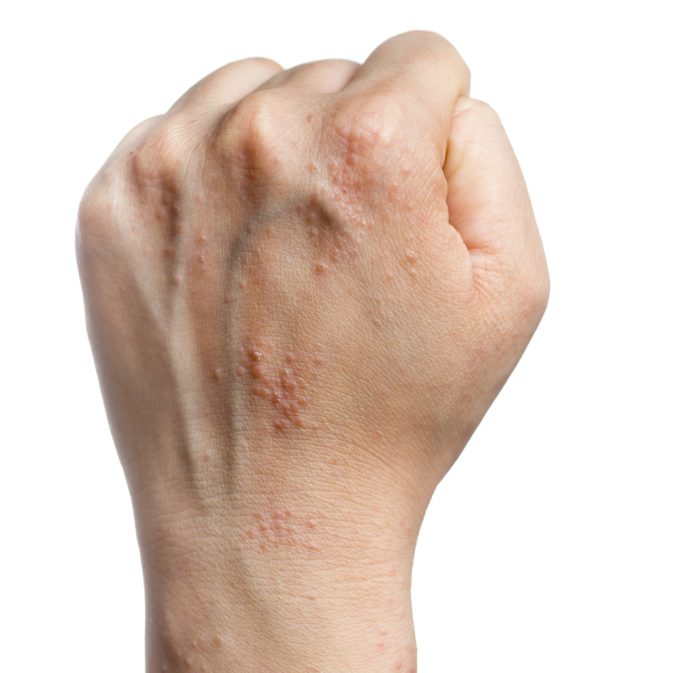
Depending on the factor that provoked the appearance of watery pimples on the palms, there are:
- allergic dermatitis - a reaction of the epidermis to contact with chemicals, medications, animal hair, pollen, etc.;
- contact dermatitis - most often occurs due to mechanical exposure to an irritant, which can be ultraviolet rays, jewelry, synthetic fabrics, etc.;
- atopic type of disease of non-infectious and non-allergic nature.
Hives on the hands - why do the hands suffer more often?
- Chronic liver diseases in which histamine metabolism is disrupted (excess is observed).
- Gastrointestinal diseases, dysbacteriosis.
- Arthritis.
- Neoplasms.
- Disturbances in the functioning of the endocrine system.
- Food allergies.
- Medicines.
The most likely candidates are antibiotics and local anesthetics. - Cold urticaria on the hands and above. Harbingers of allergies are tingling, slight itching in the hands when frost sets in. Swelling of the hands and fingers is common.
- Household dust, hair, dander, and pet saliva can also cause a rash.
- The causes of mechanical urticaria on the hands also lie in insect bites.
In cases with urticaria on the elbows and other parts of the arms, doctors often find it difficult to diagnose: too many other skin diseases and internal pathologies give a similar rash.
That is why the approach to research and treatment is strictly individual.
Allergies in the form of hives on a person’s hands are quite common. Almost 10% of the population of our planet have dermatological diseases of the skin of the hands.
https://www..com/watch?v=cOiAvUaB-Ng
What is urticaria on the hands (urticaria)? This is a skin disease characterized by rashes that resemble stinging nettle stings.
Urticaria is quite difficult to distinguish from other types of allergic reactions. Most often, urticaria occurs on the hands; photos, symptoms and treatment will be discussed below.
Urticaria on the palms of adults and other parts of the body is characterized by the appearance of red blisters, most often round in shape with a pink edging along the contour. Blisters come in different sizes and protrude slightly above the skin.
Nettle fever may be accompanied by swelling and itching, as well as fever. Sometimes Quincke's edema and burning of the organ on which the rash appears occurs.
In severe cases of the disease, spots and blisters may change their location, appearing in some places and disappearing in others.
The most important difference from other skin rashes is that after recovery there are no scars or any other marks left on the skin.
There are 3 forms of the disease:
- spicy;
- chronic;
- recurrent.
Acute is characterized by a rapid course, the disease manifests itself within 1-2 hours and lasts no more than 15 days. Chronic can last for several weeks or even months. Recurrent is characterized by repetition of attacks of the disease.
Let's see what urticaria looks like on the palm: photos are available below.
If hives appear on your arm, the causes of the rash can be due to a variety of factors. It is very difficult to identify all the sources of urticaria. Every year people find new reasons for its occurrence.
When an allergen comes into contact with a person, the protective function of his body will begin an immediate defense. The production of a special substance, histamine, will begin to neutralize the allergen. But too much histamine is harmful. In the papillary layer of the dermis, which is located in the connective tissue, an acute inflammatory process occurs.
And yet, what causes hives on the hands? Urticaria can appear either as a result of an allergic reaction to a certain substance or as a result of some disease in the human body.
The causes of urticaria are divided into several types:
- Food: occurs when eating foods that are allergenic to humans: honey, nuts, citrus fruits, chocolate, seafood, milk, pork, spices, sweets and juices with dyes, etc.
- Medicinal: is the result of the use of drugs: antibiotics, vitamins, dietary supplements, vaccines and any other drugs.
- Cold: appears due to a sharp change in air or water temperatures.
- Insect: with insect bites, usually bees, wasps.
- Solar: manifests itself from exposure to harmful ultraviolet radiation.
- Mechanical or physical: when the skin of the hands is exposed to external irritants: detergents, washing powders, cosmetics and personal care products; rubbing with clothes or any objects.
- Aeroallergenic: allergies to pollen, perfume, tree fluff, aerosol air fresheners, animal hair.
- Autoimmune: Antibodies in the body destroy beneficial antibodies, organs, or tissues.
- Pathological: occurs due to disease in the body: pathology of the liver, gastrointestinal tract and infection with viruses, bacteria or parasites.
- Nervous: quarrels, nervous shock, depression.
If you suspect urticaria, you should contact a dermatologist as soon as possible, because there is a high risk of a severe course of the disease: migration of the rash to other organs and Quincke's edema.
Self-medication is strictly contraindicated! Only a specialist should make a diagnosis and prescribe treatment!
It is impossible to make an accurate diagnosis of “urticaria” with one hundred percent certainty, because there are no specific tests to determine this disease.
The diagnosis of the patient is made based on the general picture of the examination: the patient’s answers are taken into account, the skin is examined, skin tests for allergens are carried out, and additional blood tests are carried out for the presence of other diseases.
To get a clear picture of the disease, it is important to determine its cause. An examination by several specialists may be required: an allergist, an immunologist, a dermatologist, and sometimes by specialist doctors: a gastroenterologist, otolaryngologist, dentist, gynecologist.
If the cause of the disease is not established, treatment may not be effective!
Treatment regimen for nettle rash on hands:
- searching for the causes of rashes;
- taking antihistamines;
- taking medications to remove the allergen from the body, drinking plenty of fluids;
- treatment of inflammation with sedatives;
- herbal compresses to relieve swelling and itching;
- diet;
- treatment of concomitant diseases, against the background of which urticaria appeared on the finger or palm.
To relieve itching, you can take tablet medications: Fexofenadine, Loratadine, Astemizole. They are effective in this regard and do not cause side effects such as drowsiness.
To get rid of itching and burning locally, non-hormonal ointments for urticaria on the hands are suitable: Fenistil, Gestan, Nezulin. They should be carefully applied in a thin layer without rubbing onto the affected areas.
You can make compresses with solutions of menthol, diphenhydramine, salicylic acid.
When identifying the cause of hives, you need to get rid of the irritating factor. If it is a food allergy, then it is necessary to remove the source of the disease from the body and stop eating it. For elimination, plenty of fluids and adsorbent drugs are prescribed: activated carbon, Almagel, Polysorb, etc.
Hands should be washed only with warm water and gentle detergents should be used.
If you have urticaria, you should avoid drinking alcohol, smoking, and stress.
In order not to provoke a relapse of the disease, you should not take the following drugs: Aspirin, Codeine, ACE inhibitors.
For urticaria, antihistamines are prescribed orally: Zyrtec, Erius, Telfast, Cetrin, Claritin.
If such therapy is ineffective, the dermatologist prescribes glucocorticoid medications: Dispropane, Celeston and hormonal ointments. All about the treatment of urticaria with drugs of pharmaceutical origin can be found in the article at the link.
In case of complications with Quincke's edema, Epinephrine is prescribed.
The use of traditional methods of treatment must be agreed upon with the attending physician in order to avoid allergic reactions and ineffective treatment.
- Dill juice for itching. A bunch of fresh dill is washed with water, the juice is squeezed out and applied to the skin of the hands for 30 minutes. Dill juice soothes the skin and relieves itching.
- Calamus root powder. Dry the calamus root, grind it into powder and take 0.5 tsp. before bedtime, with liquid.
- Baths made from infusion of wild rosemary herb. Take 1 liter of prepared infusion of wild rosemary herb and lower your hands for 20 minutes. The skin will recover faster and calm down.
- Celery juice. Take 0.5 tsp of fragrant celery juice. 3 times a day. You can prepare it yourself or buy it at the pharmacy.
- Nettle infusion. To prepare an infusion of dead nettle (nettle), you need to pour 1 tbsp. l. crushed leaves with 1 cup of boiling water, cool, divide into 3 servings and take 3 times a day.
More folk remedies for hives can be found here.
Patients with eating disorders should adhere to
hypoallergenic diet
, do not eat new and non-specific foods for the area.
When diagnosing, it is very important to correctly determine the source of the disease. Seeking help from a specialist at an early stage and strictly following the prescribed treatment plan is the key to a positive outcome and the disappearance of rashes without a trace.
What will Elena Malysheva say about urticaria? Let's find out the opinion of a famous therapist in the next video.
See inaccuracies, incomplete or incorrect information? Do you know how to make an article better?
Would you like to suggest photos on the topic for publication?
Source: https://skincare-gid.ru/krapivnitsa-na-rukakh/
Why do pimples itch?
Pimples on the inside of the hand are very itchy in almost all cases. Why does this happen, what causes itching? In fact, itching is a natural reaction of the epidermis to the course of atypical processes in the body. The very fact that pimples on the palms itch may indicate that the patient has an infectious disease (scabies, chicken pox, measles, fungus, etc.), so if blisters appear, you must definitely visit a dermatologist.
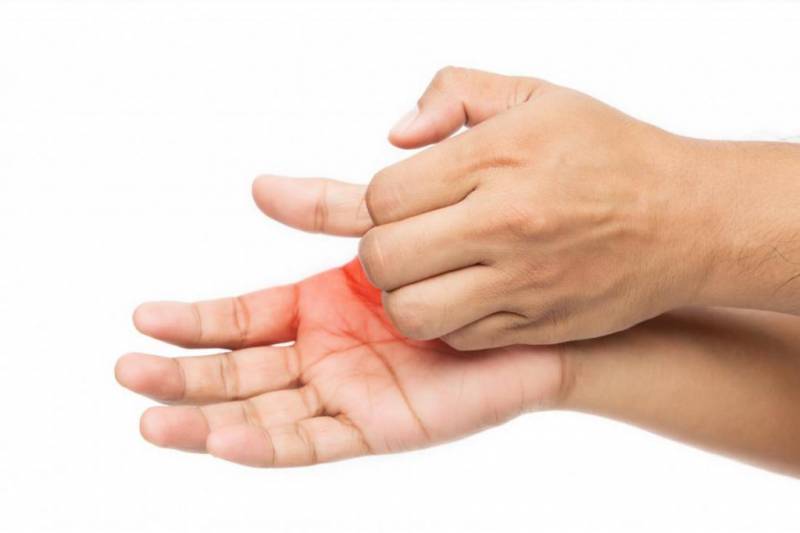
Therapeutic measures
After undergoing a full examination and establishing the cause of the disease, the specialist determines what treatment will be. Regardless of the tactics, the main goal of therapy is to eliminate the allergen that triggered the hives.
Only in the absence of interaction of the irritant with the body, the disease will not make itself felt again.
Drug treatment
All therapeutic actions to get rid of pathology consist of fulfilling three main points:
- eliminate the symptoms of pathology;
- cleanse the body;
- stop the inflammatory process.
Therefore, in all cases, experts prescribe antihistamine drugs, which help quickly relieve allergic symptoms and restore normal conditions.
In addition, such means prevent further development and damage to other systems and organs. The most popular are Erius, Cetrin, Claritin, Zyrtec.
In the absence of a positive result, the dosage is usually increased up to four times. After taking these medications, first generation medications may be prescribed:
- Tavegil;
- Suprastin;
- Diphenhydramine;
- Acrivastine.
On this topic
- Hives
How to prevent an allergic reaction like hives
- Inna Viktorovna Zhikhoreva
- July 28, 2020
It would also be useful to use sorbents that promote faster removal of the allergic substance from the body if it enters through the digestive system. You can take activated carbon or any drug that has similar properties and does not cause harm to health.
To relieve itching and inflammation from the fingers and palms, creams or ointments that have a local antihistamine effect are ideal. It can be:
- Fenistil gel;
- Soventol;
- Psilo balm.
In case of a more complex course of the disease, a specialist may prescribe immunostimulating therapy or corticosteroids. It is important, however, not to forget that such treatment is used in the most extreme cases, since, despite their effectiveness and rapid action, such drugs contribute to severe suppression of the immune system.
Typically, such methods are used for Quincke's edema. Intradermal injections are given for no more than three days, and tablets are recommended to be taken for 14 days.
Diet
Equally important in the treatment of urticaria on the hands is adherence to a proper diet. To create a menu, you first need to identify the allergen. This can be determined by taking an allergy test.
For these purposes, the patient is prohibited from eating anything during the day. Gradually, one product is introduced every day until it is determined what exactly causes the allergic reaction.
A person who has been diagnosed with urticaria is advised to exclude the following foods from their diet:
- citrus;
- alcohol;
- nuts;
- honey;
- chocolate;
- flour;
- red and orange vegetables and fruits.
Can be used:
- whole milk;
- green apples;
- chicken meat;
- boiled vegetables.
Meals should be fractional, up to 5 times a day in small portions.
How to treat
It is important to understand that a rash on the palm is not an independent disease. This is a symptom that needs medical correction. But if the underlying cause of the rashes is not addressed, they may reappear. To get rid of the problem forever, you need to treat the underlying disease.
To get rid of such a cosmetic defect as pimples on the skin of the palms, you need to lubricate them with vitamin E, which is sold in any pharmacy and comes in liquid form. Tocopherol moisturizes and softens the epidermis, launches regeneration processes. Oily vitamins are not used as monotherapy, since the maximum therapeutic effect from them can only be obtained if they are used in combination with other drugs prescribed by a doctor. To treat diseases that can cause acne on the feet and palms, experts prescribe:
In addition to pharmaceutical preparations, doctors often recommend wiping your palms with a decoction of birch buds, fresh blackberry leaves, willow bark, or applying a paste of cabbage leaves or raw potatoes to the affected areas.
Ways to diagnose the source of the rash
Hives on the fingers are treated within two weeks.

Only a doctor can determine the exact treatment regimen. You should not self-medicate based on the experience of friends or people from the Internet. Each person has their own contraindications and reactions, which only a specialist can take into account.
The disease itself goes away as the allergen is eliminated from the body. To speed up this process, doctors prescribe:
- enterosorbents;
- diuretics;
- special food that does not contain allergens and involves drinking large amounts of liquid.
In addition, the patient will undergo symptomatic treatment with:
- anti-inflammatory ointments that reduce itching (they can be hormonal and non-hormonal);
- sedatives;
- antiallergic drugs (taking antihistamines is a must for any form of urticaria).
The following can be used as effective remedies for urticaria relief:
- Diuretic herbs, for example, a decoction of raspberry roots.
- Anti-inflammatory agents, such as mint tincture, chamomile and thyme decoctions, castor oil and celandine juice.
- Soothing decoctions and tinctures, for example, from valerian root. A side effect of these drugs is increased drowsiness.
Rash on the palms of children
Various rashes very often appear on the hands of babies: in infants it is usually prickly heat, but the search for the cause of the rash in an older child needs to be approached more thoroughly. So, pimples on the hands may indicate:
Rashes with hyperemia of the palms can occur with pathologies of the vascular system. In this case, pinpoint hemorrhages in the form of small nodules will be visible on the skin on the inside of the hand. This symptom is called hemorrhagic rash. If it quickly spreads throughout the body, the child must be hospitalized immediately, as pinpoint spots may indicate inflammation and damage to small and large blood vessels.
To rid a child of pimples, the affected palms are lubricated with antiseptics (iodine solution, calendula tincture or pale pink manganese solution). It is necessary to treat rashes at least 2-3 times a day.
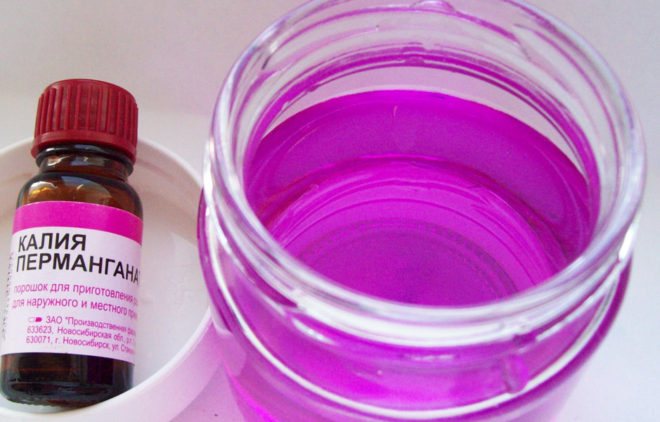
What is a rash?
The normal appearance of the skin reflects the internal health of a person, but as soon as malfunctions occur in the body, they first appear on the dermis.
Peeling, red rash, and many other symptoms may indicate internal disorders of the body. That is why there are a number of different types of red rash, differing in appearance and causes of occurrence:
- A vesicle is a small cavity filled with serous fluid inside and has a size of no more than 1 centimeter. They are divided into single and multi-chamber. After they open, ulcers and erosions remain on the dermis;
- Abscesses are divided into a number of types: deep, follicular, superficial, but all of them are distinguished by one nature - there is pus in the cavity of the pustule;
- Papules or nodules can range in size from 1 ml to 3 cm. Their presence changes the color and consistency of the skin;
- Blisters are small formations on the skin. Their color is pink, and their life span is quite short. Very often they do not require medical intervention and disappear after a few hours;
- Spots - change the color of the skin, while the damaged dermis continues to be on the same level as the healthy one.
Bubbles Ulcers Papules Blister Spots
Diagnosing the source of the rash is a rather difficult issue. This diagnosis can only be made by a dermatologist.
Diagnostics for adults:
- Visual examination - the rash is checked for characteristic features, quite often they are individual for many diseases;
- To exclude a rash as a symptom of an infectious disease, a number of tests are prescribed: studying the secretion of ulcers;
- blood test - this additional information helps to provide additional information for diagnosis.
Differential diagnosis of rash in children:
- Initial examination of the child and palpation of the rash for characteristic features;
- Comparison of clinical examination with other research methods such as the primary element of the rash and the nature of its distribution. For example, if the rash appeared on the first day of illness, then it is a viral infection. There is a summary table of these comparisons that helps the doctor determine the source of the rash.
A rash is an external change in the skin and mucous membranes that usually appears as a result of various diseases and altered conditions of the body. Very often, rashes are a signal of the presence of an irritant or a certain pathology. The infection also causes altered conditions of the skin; we will consider the causes of these phenomena below.
The main causes of rash formation are:
- infections;
- allergic reactions;
- cardiovascular pathologies.
Redness often appears due to infection in the body. Then there are other symptoms: fever, chills, sore throat or stomach, cough, diarrhea, runny nose.
Often a rash appears as a symptom of an allergy. In this case, it is almost always accompanied by severe itching. The reason to suspect this is the absence of symptoms of infection and contact with a possible allergen.
For prevention purposes
To prevent the initial or re-appearance of blisters on the palms, you must constantly monitor your hygiene:
Why are allergic rashes dangerous?
Hives on the palms are accompanied by itching. Constantly scratching your hands can lead to irritation and injury to the rash. Because of this, a bacterial infection often occurs.
The most dangerous complication of urticaria on the hands is an allergic reaction towards the respiratory tract. If you do not isolate the patient from the allergen, he may experience swelling of the larynx. In the absence of medical care, death is likely.
To avoid all possible complications of urticaria, you must consult a physician immediately after its occurrence. If possible, the influence of the irritant on the patient should be eliminated. If it is not identified, then you will have to visit other doctors - an allergist, immunologist and dermatologist. They will confirm the diagnosis and also conduct skin tests to determine the allergen. After this, you can begin treatment.
We suggest you familiarize yourself with White bumps on the skin of the hands
Rash on the palms and soles of a child in the form of pimples, blisters or spots, photo with explanations
Rash! It would seem that why doesn’t she appear! However, each case requires attention, because if you do not take timely measures, you can miss a serious illness.
It is especially unpleasant when it is found on the palms and soles of a child. He may experience discomfort when walking, and contagious diseases that cause the rash can be passed on to healthy children. Why does she appear? How to find out whether it is dangerous or not?
Rash in all its diversity
Pimples and redness on the skin are always unpleasant, especially on the hands. They make others fear infection; parents of other children forbid them to play with a sick child. Of course, the reason for the appearance may be completely harmless, but no one wants to take risks.
There are many types of rashes:
- watery blisters occur in some viral diseases; when they open, they can serve as an entry point for infection;
- blockage of the sebaceous glands looks like white or black dots on the skin;
- inflammatory processes in the sebaceous glands lead to the formation of subcutaneous papules;
- purulent blisters are painful and greatly disturb the child;
- dry pimples may be crusty;
- spots with scales and blisters often also itch;
- The red rash is caused by both harmless causes and a number of infectious diseases.
What can cause rashes on the hands and feet of children?
There are several reasons for the appearance of a rash on the palms and soles of a child. The most harmless is prickly heat caused by overheating. It may go away on its own, but small red pimples can easily be confused with a rash of another origin. No matter why a rash appears on a child’s palms, you need to show it to a doctor (we recommend reading: rash on the back after a fever in a child: causes, methods of treatment).
You should not delay seeking medical help. Some diseases manifest themselves as rashes for a short period of time, and when the pimples go away, it will be more difficult to make a diagnosis. Other types of rashes may develop, causing further deterioration of the skin.
Inflammatory processes in the arms and legs will prevent a child from playing normally, and a schoolchild from studying. To save a child from discomfort, it is necessary to promptly identify the pathogen and begin treatment.
Fungal infection
Pathogenic fungi are present on the skin of any person. However, they begin to manifest themselves when immunity decreases. Fungal diseases can also be caused by stress, insufficient and unbalanced nutrition, and long-term use of antibiotics. The fungus can also develop against the background of hormonal imbalance or intestinal diseases.
The fungal disease is accompanied by the appearance of an allergic rash consisting of pustules. A pustule is a round pimple that contains pus inside. Later, crusts form in place of the pustules.
The rash may cause a burning sensation and itching. Localization may vary, but most often the feet and palms are affected.
Treating fungus is long and difficult. The disease is chronic and relapsing. However, it is necessary to treat persistently, since the fungus can spread throughout the body, leading to damage to the scalp and alopecia.
The disease is especially severe in those suffering from diabetes, asthma, and vascular diseases.
To avoid complications and secondary infection with other pathogens, you need to contact a dermatologist and follow all his instructions.
Insects and parasites
An example of the cause of such rashes is worms. They are found inside the body, most often in the intestinal lumen, but the body's reaction to them often leads to the appearance of a rash. Rash caused by worms comes in different types:
- small red pimples, like hives;
- affected areas that look like eczema;
- acne or boils;
- neoplasms on the skin such as papillomas and papules.
The resulting rashes are itchy, their appearance depends on the type of parasites that have settled in the body. Treatment of itchy spots will only give results if it is combined with anthelmintic therapy.
A rash occurs on the palms and when infected with scabies (pictured). The scabies mite that causes the disease settles in the upper layer of the skin. Infection occurs through contact with a sick person or an object that he touched. The pimples caused by scabies are very itchy, do not give the child any rest, the itching intensifies at night (more details in the article: scabies in a child: symptoms with photos and methods of treatment).
If you have the slightest suspicion of scabies, you should consult a doctor, as it can spread throughout the body and is highly contagious. The patient must be isolated and provided with separate towels and bed linen.
Insect bites usually result in redness, swelling, or a blister at the site of the skin break. They may be accompanied by severe itching or even severe pain. A rash that looks like hives appears if a child is allergic to insect venom. The rash may appear as multiple bites from fleas, lice or ants.
Skin diseases of other nature
Flat papules, merging into large solid spots covered with silvery scales, appear on the skin with psoriasis. The formation of papules is accompanied by severe itching. The disease is autoimmune in nature and is not dangerous for others. However, it is impossible to recover from it; you can only stop the development of the disease and stop relapses.
Eczema on the hands is also not contagious. It is believed to be allergic in nature, but the exact origin of the disease is unknown. At risk are children who have this disease in their family. Small pimples appear on the skin, their formation is accompanied by redness, swelling and severe itching.
Medicine knows a considerable number of diseases, the manifestation of which is a rash. Rashes often signal diseases of the internal organs:
- Lesions of the gastrointestinal tract can cause pyoderma gangrenosum, in which spots similar to insect bites appear on the legs, but later, if left untreated, the spots turn into ulcers with purple edges.
- Liver diseases at the initial stage make themselves known by characteristic skin rashes. The content of bile acid in the blood increases, which leads to general poisoning. When the bile ducts are blocked, a rash forms on the palms and soles of the feet. Externally, the spots resemble burn marks. The rash can be combined with spider veins; they are very itchy, especially at night.
- Nervous eczema may appear on the hands. It indicates a malfunction in the nervous system. The causes of rashes can be nervous tension and stress. The rash is similar in appearance to urticaria and is very itchy (we recommend reading: what urticaria looks like in children and photos of the initial stage).
- In diseases of the blood or blood vessels, damage to the walls of the capillaries leads to the appearance of small spots of bright red color - petechiae. It helps to recognize their origin that the rash does not change color when pressed. The rash covers the entire body. In children, especially newborns, rashes are possible due to Werlhof's disease - blocking of capillaries and small arteries with blood clots. Petechiae occur at injection sites and are painless. The rash may indicate hemoblastosis or be a consequence of diabetes mellitus. In diabetes mellitus, it indicates a change in blood sugar levels and appears on any part of the body, including the feet.
In what cases is it necessary to consult a doctor?
The appearance of changes on the skin that are not caused by known external causes always signals some kind of disease. Often other symptoms appear along with pimples or spots, which suggests a particular disease. You can treat the rash yourself only if its origin is precisely known. In other cases, you should immediately consult a doctor.
Using brilliant green to combat itching will change the color of the spots; ointments can distort the picture. For treatment to be successful, it is necessary to help the doctor make the correct diagnosis. You should not postpone visiting a specialist, since the manifestations of the disease may go away, but the disease itself will remain, and it will be more difficult to diagnose it.
https://www.youtube.com/watch?v=Ja5KDAwJ_3s
When a rash appears, depending on the accompanying circumstances, they consult different doctors:
- after taking medications, contact with household chemicals, introducing a new product, or the presence of strong odors, consult an allergist;
- if skin manifestations are combined with high fever and poor health, contact an infectious disease specialist;
- in case of intensification of manifestations, the formation of blisters, the appearance of a burning sensation, tingling, bleeding - contact a dermatologist;
- the spread of redness after a tick bite, even if considerable time has passed since the bite, is a reason to immediately visit an infectious disease specialist (we recommend reading: what mosquito bites look like in children: ways to relieve itching and swelling with photos).
READ ALSO: tick bite in a child: symptoms, consequences, treatment methods
Early seeking medical help will help you quickly take action even in the event of a dangerous illness. You should not risk your child’s health by using home methods to combat skin pathologies.
Source: https://www.deti34.ru/simptomy/kozha/syp-na-ladoshkah-u-rebenka.html
Causes
A variety of causative factors can lead to the appearance of various rashes on a baby’s skin. The severity of symptoms in this case usually varies and depends on many initial factors. Thus, the course of the disease in a newborn baby can differ significantly from that in a teenager.
Parents should remember that they should not underestimate the appearance of various rashes in their child. These symptoms may be just the “tip of the iceberg” and indicate the presence of pronounced disorders in the condition of the child’s body.
If skin rashes appear, parents should definitely consult a doctor. It is impossible to carry out diagnostics at home, since it requires not only a clinical medical examination and examination, but also tests.
Rash on a child’s palms and feet – causes and treatment
A rash on the palms is a sign of many skin problems. This is mainly contact dermatitis or the result of chemical or toxic exposure to the skin. However, there are other more serious causes of rash on the palms.
A rash on the palms and feet of a child or adult can appear as a result of bacteria or viruses, an allergic reaction to certain foods and medications, or be caused by calluses.
Some diseases can also cause rashes on the palms and soles of the feet.
A person is constantly in contact with the environment, and most often this is through the hands. Therefore, it is not surprising that many diseases begin with the hands.
What kind of rash is there?
Rashes on the palms and soles of children can look different:
- in some cases, bubbles appear on the palms, containing liquid inside;
- if there is pus in the rash, they are called pustules;
- when the rashes are rough and stand out against the background of the skin, then blisters are diagnosed;
- when nodular elements are present inside, they are called papules;
- small rashes on the skin are called spots;
- in case of deep damage to the skin and discharge from it, erosion or skin ulcer is diagnosed.
View gallery
When a rash appears in a child, only a doctor can determine its type and prescribe the correct therapy.
Dyshidrosis
When a child develops a rash on the feet and palms, which manifests itself in the form of specific blisters filled with fluid, this may be a signal that dyshidrosis has developed. This is an infectious disease that affects the skin of the feet and hands.
Pediatricians advise monitoring the child’s condition especially closely in the spring and summer. In the hot season, relapses of the disease occur much more often and are associated with blockage of the sebaceous glands. Excessive sweating can cause dyshidrosis in a baby.
Experts identify several factors influencing the development of pathology:
- excessive sweating;
- frequent exciting situations, stress;
- fungal diseases of the dermis;
- heredity;
- diseases of the endocrine system;
- gastrointestinal pathologies;
- allergy.
According to medical statistics, a child susceptible to atopic dermatitis and diathesis is more likely to suffer dyshidrosis.
Dr. Komarovsky believes that the cause of the development of the disease is an allergic reaction of the digestive system, so it is necessary to introduce a new product into the children's diet with caution. If the child is bottle-fed, it is worth replacing the milk formula with another one with a lower concentration.
It is necessary to know the main symptoms of the pathology in order to recognize the disease in time and take measures to eliminate it.
- Dyshidrosis manifests itself in the form of a rash; it most often affects the palms, inner surfaces of the fingers on the upper and lower extremities, and feet.
- At the initial stage, the child notices an uncomfortable tingling sensation in the area of the palms and feet. This leads to the baby starting to scratch the affected skin, resulting in a rash. It begins to cause itching and burning.
- Redness and specific balls and blisters appear on the dermis, which itch and fill with fluid.
- The bubbles are small in size and reach only a few millimeters. They have a transparent tint, but the skin around them becomes red due to constant scratching.
- Over the course of a week, a maximum of 10 days, the rash on the palms and feet goes away. They may open on their own or dry out. In this case, the healing process is accompanied by unpleasant sensations: swelling occurs, erosions appear in place of former blisters, and the dermis becomes painful.
- Finally, the skin begins to peel off. When using special means, the disease is eliminated from this moment in a few days.
Parents should remember that true dyshidrosis is distinguished by the absence of new blisters. After self-opening of the rash, no new manifestations should appear. The baby may develop dry dyshidrosis, which is characterized by the absence of the stage of bubbles with liquid, and the peeling stage immediately begins.
Treatment of pathology is not difficult if you consult a specialist in time.
Pediatricians often prescribe a specific therapeutic regimen consisting of antihistamine medications: Suprastin, Fenistil, Diazolin.
Sorbent drugs (Activated carbon, Smecta, Enterosgel, Enterosorb) and sedatives that can be used in childhood are included: for example, Valerian.
Sometimes the doctor prescribes additional medications or vitamin complexes for calcium levels.
For external use, antimicrobial drugs with a drying effect are prescribed: Brilliant Green solution, Fukortsin. Also, products that can quickly dry out rashes include: Sudocrem, Furacilin solution, zinc ointment.
A prerequisite is the use of corticosteroid medications: Dermovate, Sinaflan, Lorinden, Flucinar.
It is not recommended to use these drugs directly; a small amount of ointment should be added to baby cream and applied in moderation to the skin.
Symptoms of erythema
Most often, allergic manifestations are accompanied by the following symptoms:
Source: https://xn--80ahsaqcbqq.xn--p1ai/kozha-simptomy/krapivnica-na-ladonyah-u-rebenka.html
Treatment Options
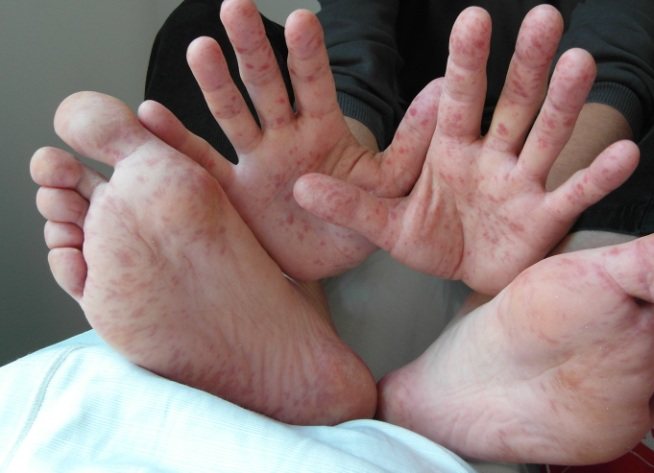
In order for the therapy to be effective and not lead to serious consequences, it is necessary to consult a doctor: only he will establish an accurate diagnosis. The use of certain medications will be determined by the cause of the pathology.
If the rash is accompanied by a high temperature, you should immediately seek help and call an ambulance.
If it happens that your child has a rash on the feet, arms, buttocks, buttocks, you definitely need to take the first steps to eliminate the disease:
- A specialist needs to be called to your home. You should not travel through the entire city on public transport - your child may have an infectious disease, as a result of which you will infect others. It is very important that a patient who has a rash is not near expectant mothers - at least until the doctor rules out rubella.
- If you suspect that your child has meningococcal infection, you should also call an ambulance immediately.
- It is strictly not recommended to smear the elements of the rash with any substances, including the famous “green paint” until the doctor arrives. You must understand that the main cause of the rash lies inside the body. It follows from this that you will not be able to achieve the effect by simply smearing the rash. And the doctor will be able to correctly diagnose and prescribe competent treatment.
If you suspect that the rash is caused by clothing, do not forget that the material is not the only cause. Allergies in children can be caused by powder that remains on them after washing or conditioner. The best option would be to give preference to hypoallergenic hygiene products.
At home
It will be dangerous to choose traditional medicine as a treatment if you know that your child is allergic and has sensitivity to food, various herbal infusions or bee products.
We can only recommend chamomile infusions made from oak bark and string. In such cases, foot baths are made, and the affected areas of the skin are wiped with infusion. The tincture can be used to treat both children and adults. It’s easy to prepare a medicinal tincture:
- Pharmaceutical chamomile or string (3 tablespoons) is poured with boiling water - one glass. The solution should sit, after which you can wipe the skin of your feet.
Drugs
Allergic contact dermatitis is the most common pathology, which results in a rash and an increase in body temperature. There is a scheme according to which the treatment is carried out:
- If the skin on your legs is dry, then after removing the inflammation, you need to use salicylic ointment locally - three times a day. When diseased areas swell, you need to take baths containing boric acid.
- Antihistamines. To cure allergic dermatitis, modern remedies can be used: Erius, Zyrtec or Telfast. Tavegil or Suprastin can also relieve a rash on a child’s legs.
- When a colorless rash on the lower extremities itches due to allergies, the itching should be treated with topical hormonal ointments. Locoid, Elidel and Advantan are considered popular. Particular care must be taken during application; apply only to inflamed areas. Corticosteroid ointments can be used for no more than 5 days.
- To increase immunity in children, immunomodulators and vitamins are used. Physiotherapy may also be prescribed, which includes baths - radon, hydrogen sulfide or mud.
- Desensitizing drugs are prescribed only during the acute period. It is used intramuscularly - calcium gluconate, as an example.
If neurodermatitis develops, treatment is supplemented with tranquilizers, a visit to a psychologist, and sedatives. When the rash affects the legs severely, you need to undergo antibiotic therapy.
Fungal diseases of the feet affect 20-30% of people in the world, but only 2-8% of them are children. Children suffering from concomitant diseases, with a weakened immune system, and from families with aggravated heredity are infected.
READ MORE: The child hit his head. What to do if a child hits his head?
Advanced forms of foot fungus are extremely rare among children - these are mainly children from unfavorable social environments.
The pathogen in children is Trichophyton rubrum (it is “responsible” for 95% of cases), followed by its “brother” Trichophyton mentagrophytes. And from 2 to 9% - yeast and mold fungi.
How do children get infected?
Infants and young children - in the family, during close contact with mother and father. Foot fungus in children is a contact disease, transmitted through household items and touch when the protective function of the skin is impaired.
Today, there are various treatment methods based on the experience of dermatologists around the world. Specific therapy is based on combating the cause that caused the disease.
General recommendations include:
- calm environment, opportunity to relax
- measures aimed at strengthening immunity;
- exclusion of allergenic products, synthetic clothing, exclusion of home repairs;
- mother's positive attitude;
- in the presence of a bacterial infection, antibiotics are appropriate;
- symptoms of an allergic reaction can be eliminated with the help of antihistamines;
- isolation of the patient from other children if we are talking about an infectious disease.
The choice of drug therapy depends on the specific disease:
- antiseptics (iodine, brilliant green, hydrogen peroxide) are indispensable for any skin pathology;
- streptocidal ointment has an anti-inflammatory, antibacterial, softening effect;
- if there is a fungal infection on the child’s heels, fungicidal drugs are prescribed (in the form of ointments, creams and tablets);
- chicken pox does not pose a significant danger; you should treat the blisters with an antiseptic and try to normalize a very high temperature.
You cannot self-medicate. When it comes to an infectious disease, it is better to show the patient to an experienced dermatologist who can make a diagnosis. Acne on a child's legs can pose a risk of complications, so timely diagnosis is key in the treatment of meningococcal infection.
Causes of pimples
The causes of rashes on the legs of a baby vary according to the main groups:
- diseases caused by infection or parasites;
- allergic reaction;
- blood and vascular diseases;
- poor nutrition and poor hygiene.
Infectious diseases
If one of the causes of the rash is infection, then you can notice how the temperature rises, chills appear on the body, the child coughs, has a sore throat, stomach, and the child may feel sick.
Such symptoms may appear immediately or several days after infection. A similar rash on the feet, body, back, face, cheeks, fingers, stomach, butt or on the arms and hands indicates the development of measles, chickenpox, rubella or scarlet fever.
The most dangerous of the infections is meningococcus, which is a bacterium caused by nasopharyngitis. Treatment for this type of bacteria is easy, but if the disease is neglected, it can lead to meningitis and subsequently blood poisoning.
Blood poisoning rashes are usually accompanied by acute fever. This is a rather dangerous disease, since from the appearance of a rash on the body and feet to the death of the patient, a day can pass.
Therefore, even with minor manifestations of the disease, you should immediately consult a doctor. With timely treatment, the chance of recovery increases.
Allergy
An allergic reaction on the body, back, abdomen, fingers, palms, buttocks, cheeks, feet in the form of numerous rashes, manifests itself after eating a certain food or when interacting with an allergen.
The allergen may be medicine, milk, chocolates, pet fur, underwear made from low-quality materials and much more.
The feet are a part of the body where there is no hair or sebaceous glands, so you can immediately rule out diseases of these skin appendages, a typical symptom of which is red pimples in children (acne, folliculitis).
Children love to walk barefoot, so there is a possibility of infection through microcracks in the skin. Products used to clean floors and carpets can also cause an inappropriate reaction in the body, since children are much more sensitive to environmental factors compared to adults.
Endocrine disorders (diabetes mellitus, obesity, hypothyroidism) can be accompanied by swelling and the formation of various types of rashes. The normal ratio of substances in the body changes.
The skin, as an indicator, quickly reacts to changes throughout the body. Pimples on a child's feet may be accompanied by elevated blood glucose levels.
Against the background of frequent acute respiratory diseases, immunity is significantly reduced, which can be accompanied by rapid fatigue and disruption of the intradermal glands. In diabetes mellitus, the vessels of the lower extremities suffer, which is accompanied by a disruption of their blood supply and tissue hypoxia.
The immune system of children is not yet sufficiently developed, so babies are more susceptible to various skin manifestations. Due to rashes and itching, the baby may become restless, lose appetite and have difficulty sleeping. Parents should solve the problem as soon as possible.
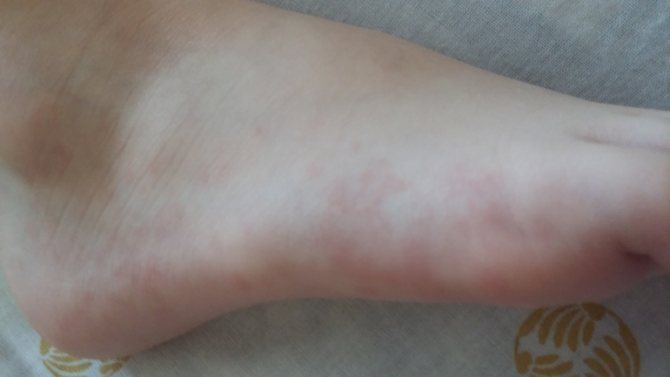
A rash on the feet of a child may appear due to the following reasons.
Infectious diseases
In children, chicken pox, measles, rubella, and scarlet fever can cause a rash.
Anything can trigger it - new foods, sweets, exotic fruits, household chemicals, cosmetics, pets.
Prickly heat
A very common occurrence in children, especially infants. Often parents are afraid that the child will freeze and wrap him up too much even in the heat.
Contact dermatitis
Babies with sensitive skin break out easily. If the skin of the feet comes into contact with brightly colored fabrics, synthetics, wool, or detergents, the development of contact dermatitis is quite possible.
Atopic dermatitis
Most often it is a hereditary disease. If one or both parents suffered from a similar problem, then it is likely that the child will also have it.
Fungus
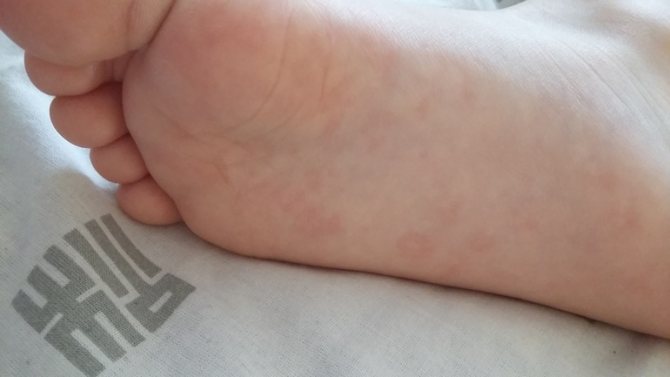
Fungal infections most often manifest themselves during weakened immunity. May be a consequence of taking antibiotics.
Parasites
Worm diseases also manifest themselves as rashes on different parts of the body.
READ MORE: Antibiotics for rotavirus in children
Bacterial infection
Excessive proliferation of streptococcus can cause skin lesions.
If you notice a rash in a child, you should not hesitate; you should definitely see a dermatologist. Parents do not need to disinfect the rash with brilliant green. This will make it more difficult for the doctor to examine the nature of the pimples and make a correct diagnosis.
Rash on the palms of a child: causes, treatment, recommendations
Having discovered a rash on the palms of a child, caring parents usually immediately begin to sound the alarm. Rashes are often caused by diseases, often of an infectious nature, threatening the health and even the life of the baby.
Sometimes they are quite harmless and go away on their own. In any case, the child’s body signals about violations occurring inside. It is the responsibility of parents and doctors to understand what a rash is and why it appears.
Types of rashes
The rash in children, located on the inside or outside of the palms and noticeable to the naked eye, differs in color, severity, structure and arrangement of elements:
- bubbles - small or large swellings of the skin, filled with clear liquid inside;
- pustules - similar to vesicles, but contain pus inside;
- papules - nodular elements in the thickness of the skin;
- spots - accumulations of small elements located on the same level with the general surface of the skin;
- blisters are dense, rough elements that rise above the general level of the skin;
- erosions, ulcers – violations of the integrity of the skin in depth, accompanied by discharge.
Important points before the doctor arrives
If any of the above types of rash are detected on the palms of the hands, parents should record other possible symptoms:
- increase in general body temperature;
- the appearance of clear nasal discharge;
- coughing;
- nausea;
- pain in the stomach or throat;
- urge to vomit;
- lethargy;
- reluctance to eat.
You should also note the possible presence of a rash on the child's feet, legs, or mouth. If nothing is observed, it is necessary to remember and write down what food the child previously ate, what objects he played with and held in his palms. It is important to promptly note the child’s contact with a sick person and the possibility of infection.
All additional symptoms and knowledge will help make a quick and correct diagnosis.
Causes of the rash
In most cases, the factors leading to rashes are:
- Infectious diseases - accompanied by signs characteristic of acute respiratory infections, occurring along with a rash or after a few days. The most common diseases with a rash on the palms of the palms:
- chickenpox (smallpox) – spots that appear at first quickly turn into blisters up to 5 mm in size, the rash usually itches; located on the palms, face, head, torso, in the mouth;
- rubella - many small spots localized mainly in the folds of the arms and legs, on the outer side of the palms, they are accompanied by signs of intoxication;
- measles - a rash appears after a rise in temperature and other signs of infection, starting from the head, then moving to the torso, palms, arms, legs; the spots are red, large, merging;
- scarlet fever - rashes in the form of small dots appear after the appearance of signs of sore throat on the second day; especially abundant in skin folds, folds, on the outside and between the fingers;
- Allergic reaction. Hives on the palms of a child appear after he has directly touched the allergen or ingested it. Substances that cause allergies: dairy products, sweets, medications, animal hair, dust, cream, powder, etc. The rash is bright red, raised, itchy; detected with a runny nose, sneezing and other manifestations of allergies.
- Diseases from insect bites, parasites. Classic examples would be bites from mosquitoes, bees, and wasps, to which the child is allergic. The most common parasite that causes a rash that itches and appears between the fingers, palms, and genitals is the mite. The disease is contagious and is called scabies. Multiple mosquito bites, flea bites, or jellyfish stings should be distinguished from a rash.
- Diseases of the circulatory system. The rash is quite characteristic, hemorrhagic, and occurs due to the destruction of small vessels and effusions into the skin. It looks like a bruise or small rash in the form of dots.
- Poor hygiene. As a result, it leads to the appearance of diaper rash, dermatitis, and prickly heat on the back of the hands. Constantly taking air baths, frequent bathing and timely changing of diapers will help to avoid problems.
If redness appears on the legs or palms, similar to a rash, the baby may have come into contact with nettles. Observe your children carefully while out and about at home, the overall picture will help the medical report.
Fighting rashes
Treatment options must be prescribed by a doctor after a thorough examination and accurate identification of the causes of the rash:
- if the disease is caused by a virus, specific treatment, as a rule, is not required;
- for infections caused by bacteria, a course of antibiotics is required;
- allergic rashes require avoidance of further contact with the allergen and the use of antihistamines;
- vascular diseases are more accurately diagnosed by a hematologist;
- Scabies will require a trip to the dermatologist.
The use of creams, ointments, balms prescribed by the doctor will relieve itching accompanied by rashes.
Do not neglect childhood vaccinations, maintain hygiene, try not to overload your child with sweets and respond in a timely manner to any rashes on the palms, feet, and legs - these are the best preventative measures against rashes.
Rash on the palms - a harmless symptom or a serious diagnosis? Link to main publication
Source: https://LechimKrohu.ru/kozhnye/syp-na-ladoshkax.html
Prevention
Preventive measures reduce the risk of developing urticaria several times. Their implementation is mandatory if regular allergic reactions occur on the back and other parts of the child’s body.
To avoid the negative consequences of urticaria in children and its development in general, it is strongly recommended:
- ventilate the room 2-3 times and do wet cleaning daily;
- monitor the humidity in the room and prevent dry air (normally, the humidity should be at least 50–60%), you can use special humidifiers;
- remove carpets, rugs, rugs, soft toys, pillows and other items that accumulate dust from the premises;
- refuse pillows and blankets with natural down;
- minimize or completely abandon household chemicals, do not wash the child’s clothes with washing powder and rinse aid, do not use glass cleaners, polishes and other products that are sprayed into the air;
- follow a diet and introduce new foods into the diet with caution;
- Do not plant flowering plants at home.
The child's body is characterized by increased sensitivity to external stimuli. Therefore, urticaria in infants and older children is very common. Whether this disease will become the cause of the development of pathologies in older age depends only on the parents and their actions to instill in their child the correct food and hygiene habits.
Author: Dana Shaimerdenova, doctor, especially for Dermatologiya.pro
